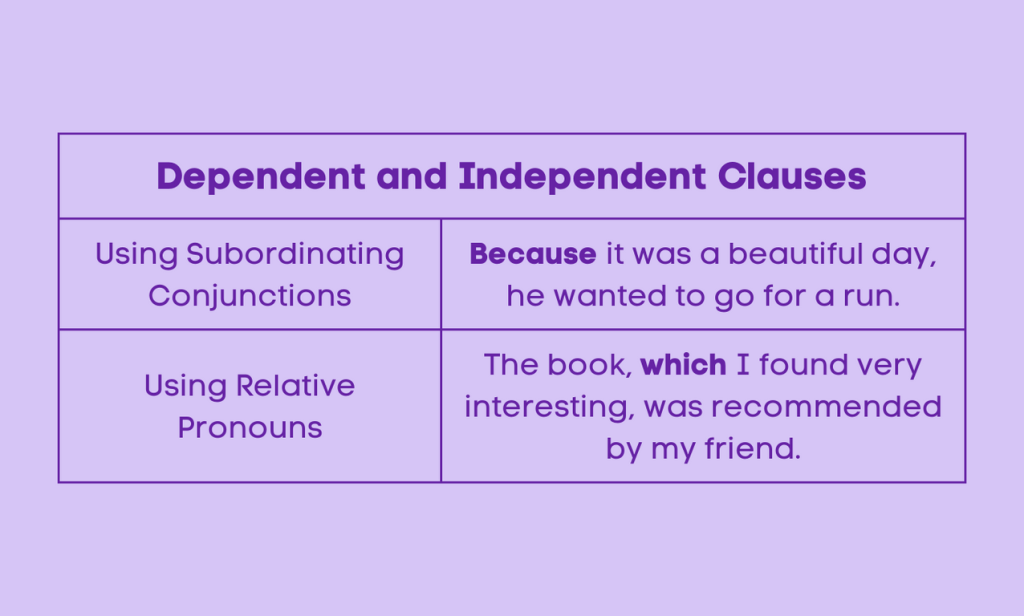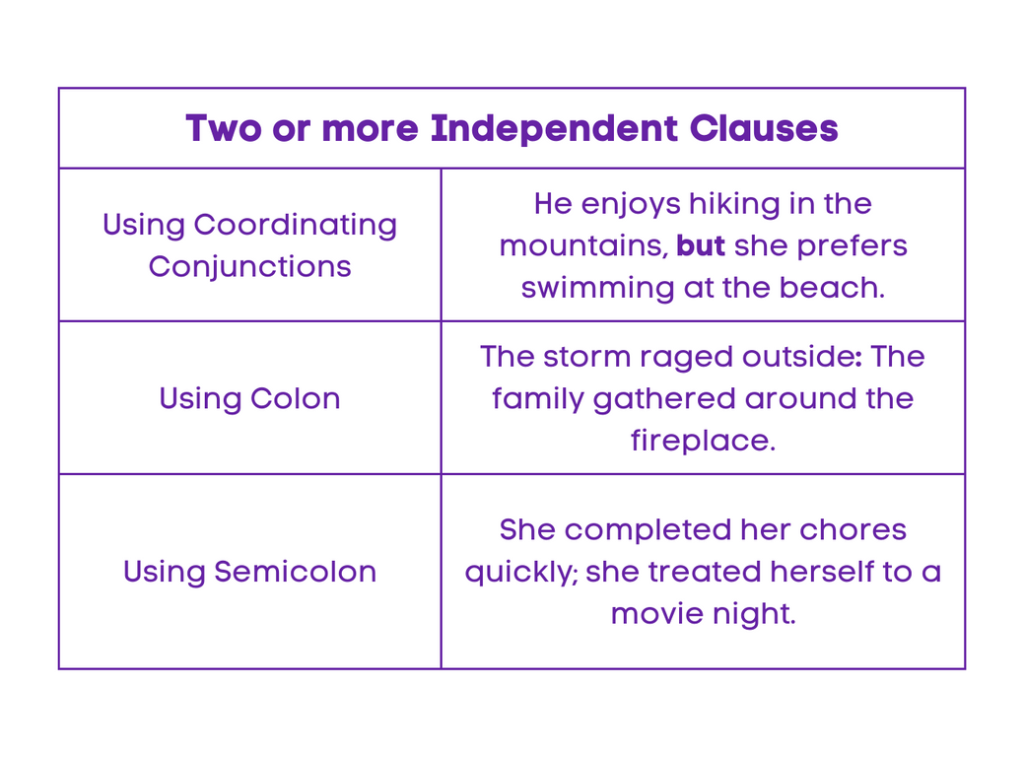Understanding Dependent and Independent Clauses in English Grammar
Table of Contents
Introduction
What is a Clause?
In English grammar, a clause is a group of words that contains a subject and a verb. It can express a complete thought and can stand alone as a sentence or be part of a larger sentence. There are two main types of clauses: dependent and independent.
Analogy of Definition
Dependent Clause
A dependent clause, also known as a subordinate clause, is a group of words that contains a subject and a verb but cannot stand alone as a complete sentence. It depends on an independent clause to form a complete thought and provide additional information.
Independent Clause
An independent clause, also known as a main clause, is a group of words that contains a subject and a verb and expresses a complete thought. It can stand alone as a sentence and does not depend on any other clause to form a complete thought.
Method
Connecting Dependent and Independent Clauses
Linking dependent and independent clauses is straightforward—since dependent clauses are crafted to be linked. Whether a subordinating conjunction (like if, because, before/after, although, once) or a relative pronoun (such as where, when, wherever, whenever) is used, connection is achieved effortlessly, and we can form complex sentences.. An independent clause can even transform into a dependent clause just by adding a subordinating conjunction or relative pronoun.
Given that dependent clauses usually contain these elements, merging the dependent and independent clauses is as simple as applying the appropriate punctuation. When the dependent clause precedes the independent one, a comma is used between them.
Example:
When you smile, the whole world stops and stares for a while.
However, if the independent clause leads, no comma is required.
Example:
The whole world stops and stares for a while when you smile.

Connecting More Than Two Independent Clauses
When connecting more than two independent clauses, coordinating conjunctions such as “and,” “but,” “or,” “nor,” “for,” “so,” and “yet” can be used. Additionally, a semicolon can be used to connect closely related independent clauses without a coordinating conjunction.
Coordinating Conjunctions
Coordinating conjunctions, such as FANBOYS (For, And, Nor, But, Or, Yet, So), are fundamental connectors in English. They seamlessly link independent clauses, allowing for smooth transitions in writing.
To connect independent clauses with coordinating conjunctions, simply insert a comma after the first independent clause and add the coordinating conjunction before the second independent clause.
Example:
She loves to dance, and he enjoys playing the guitar.
Semicolon or Colon
The colon ( : ) and semicolon ( ; ) are punctuation tools that facilitate the connection of independent clauses in writing.
A colon often introduces information that elaborates on the first part of the sentence. While it’s commonly used to present a list of nouns, it can also introduce a new independent clause. Think of it as a signal that something follows or as an indicator of “which is,” “which are,” or “thus.”
When a colon connects independent clauses, no additional words or punctuation marks are necessary. In American English, the first letter of the independent clause following a colon is capitalized, though style guides may differ on this convention.
Example:
The mystery was finally solved: The missing key was hidden in the attic.
Similarly, a semicolon can join closely related independent clauses. However, for a semicolon to be used, the connection between the clauses must be evident to the reader.
Example:
He finished his work early; he decided to take a stroll in the park.
While no extra words or punctuation are needed when the relationship between the clauses is clear, if the connection isn’t obvious, a conjunctive adverb can help.
Conjunctive adverbs, like however, although, or consequently, serve to smooth transitions between clauses, particularly when the relationship between them may not be immediately apparent.
Example:
She loved to swim; however, the pool was closed for maintenance.
By placing the conjunctive adverb after the semicolon and adding a comma before the second clause, the transition becomes seamless.
Using conjunctive adverbs not only enhances the flow of writing but also aids in guiding readers through shifts in ideas or perspectives.
Similarly, colons ( : ) and semicolons ( ; ) are punctuation marks that can also join independent clauses.
A colon introduces information related to the first part of the sentence, acting like a signal for what follows.
Example:
We’ve got a surprise for you: Your favorite band is performing tonight.
On the other hand, semicolons link closely related independent clauses without the need for additional words or punctuation.
Example:
She’s passionate about literature; her book collection fills an entire room.
However, if the relationship between the dependent and independent clauses isn’t immediately evident, you can use conjunctive adverbs like however, although, consequently, etc., to clarify the connection.
Example:
He’s a talented musician; however, his true passion lies in painting.
These conjunctive adverbs help in maintaining coherence and guiding the reader through transitions between ideas.

Examples
Example of Dependent and Independent Clause
Dependent Clause: “Because I was tired”
Independent Clause: “I went to bed early.”
Combined: “Because I was tired, I went to bed early.”
Quiz
Tips and Tricks
1. Identify the Subject and Verb
Tip: In an independent clause, you’ll find a subject and a verb that can stand alone as a complete sentence. In a dependent clause, although you might find a subject and a verb, it cannot stand alone as a complete sentence.
2.Understanding Independence
Tip: Independent clauses express a complete thought and can stand alone as sentences. They don’t rely on other clauses for meaning.
3.Spotting Dependence
Tip: Dependent clauses, on the other hand, rely on independent clauses to form complete sentences. They often begin with subordinating conjunctions like “because,” “although,” “while,” “since,” etc.
4. Punctuation Matters
Tip: When combining dependent and independent clauses, you usually need to use punctuation correctly. If the dependent clause comes before the independent clause, it’s followed by a comma. If the independent clause comes first, generally, you don’t need a comma.
Real life application
Writing: Whether you’re crafting an email, a report, or an essay, understanding how to use dependent and independent clauses properly improves the clarity and coherence of your writing. It allows you to construct complex sentences that convey your ideas effectively.
Speeches and Presentations: When delivering a speech or presentation, knowing how to structure your sentences with dependent and independent clauses helps you organize your thoughts logically. This ensures that your audience can follow your train of thought and grasp the main points you’re conveying.
Reading Comprehension: Recognizing dependent and independent clauses enhances your ability to understand written texts. It enables you to break down complex sentences into manageable parts, making it easier to comprehend the author’s intended meaning.
Analyzing Literature: In literature, authors use dependent and independent clauses to create various effects, such as emphasizing certain ideas, building suspense, or conveying emotions. Analyzing these clauses helps readers uncover the deeper layers of meaning within a text.
Public Notices and Instructions: Public notices, signs, and instructional materials frequently contain sentences with dependent and independent clauses. Clear understanding of these clauses ensures that readers interpret the information correctly, whether it’s safety instructions, directional signs, or public announcements.
FAQ's
Like? Share it with your friends
